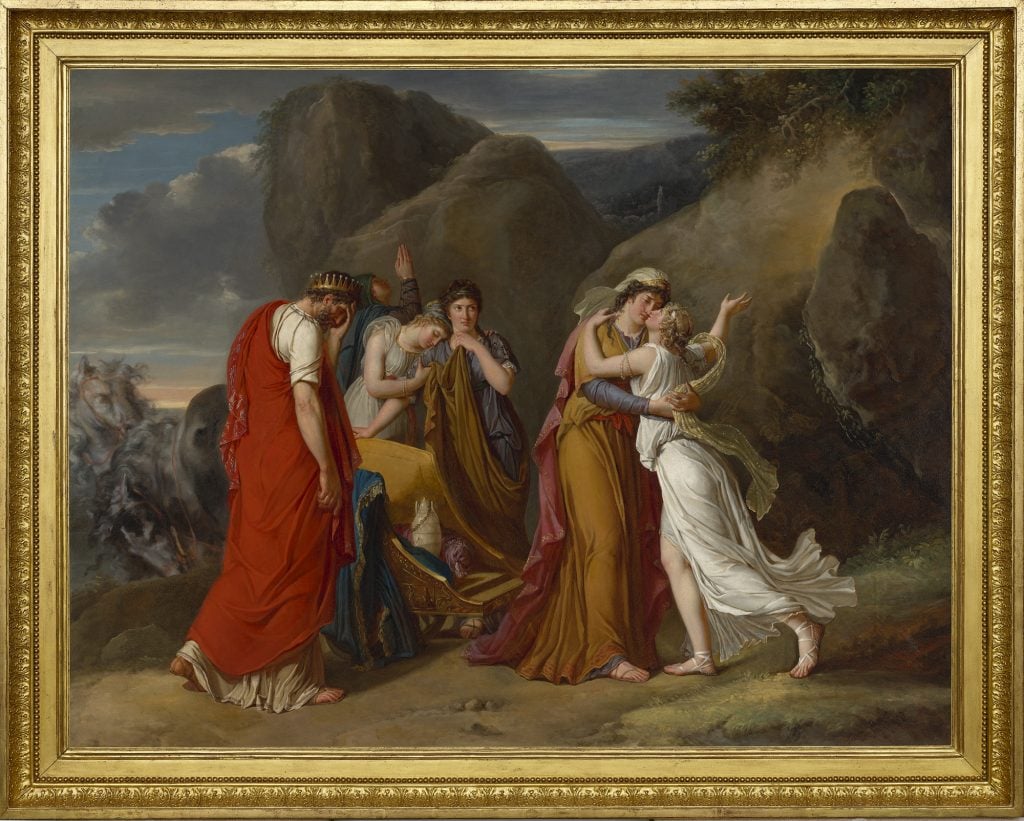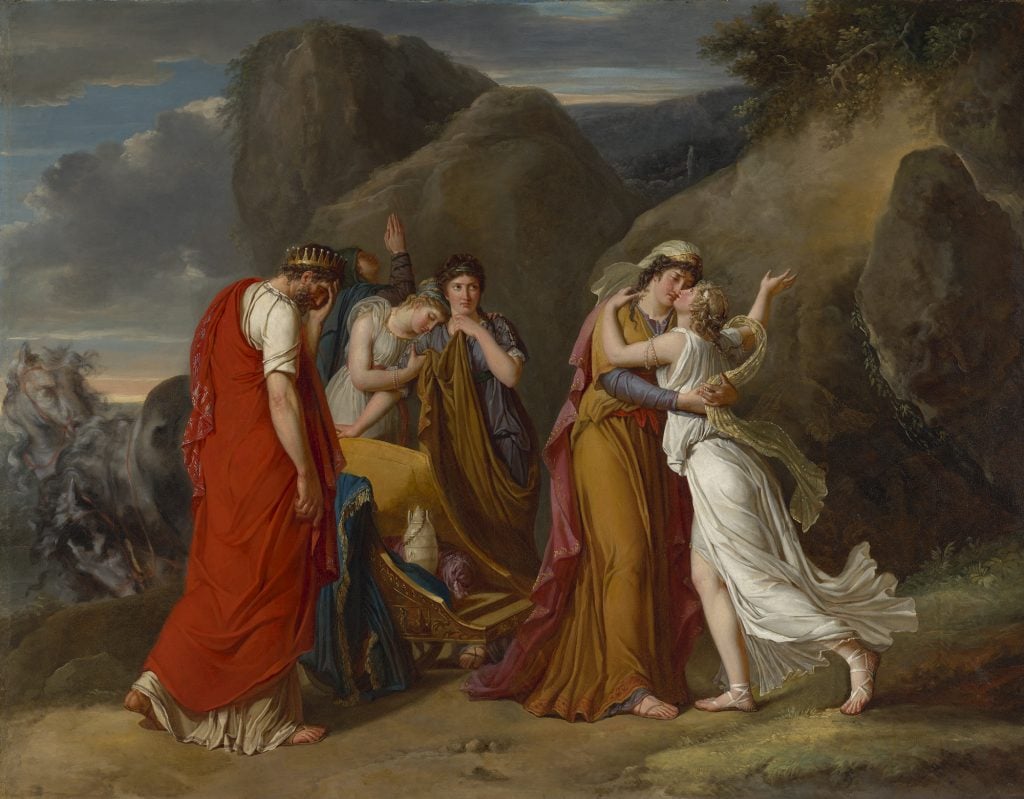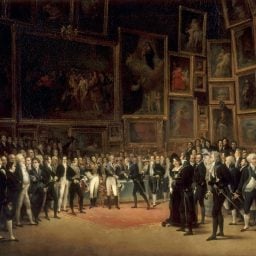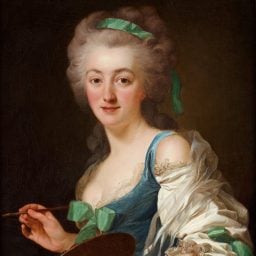The Fine Arts Museums of San Francisco has acquired Psyche Bidding Her Family Farewell (1791) by Marie-Guillemine Benoist—a rare work by a female Old Master, and the first history painting shown at the Paris salon by a woman artist.
“Marie-Guillemine Benoist is in some ways really such an exceptional artist, but also sort of typifies this moment of possibility for French women artists at the tail end of the 18th century,” Emily Beeny, curator in charge of European paintings, told Artnet News.
Before 1791, the biannual salon in Paris was only open to members of the Académie Royale de Peinture et de Sculpture, or Royal Academy—very few of whom were women. But two years into the French Revolution, the arts administration suspended that rule, and Benoist, just 23 years old, took advantage. She had not one, not two, but three history paintings accepted to the salon.
“The fact that she wanted to become a history painter makes her quite extraordinary,” Beeny said. “It was such an audacious ambition for a woman at this moment. Within the hierarchy of genres as established by the Royal Academy, history painting, which is to say episodes from literature, mythology, Roman history, the Bible, and other narrative subjects were really the exclusive preserve of men. They were seen as requiring considerable erudition, as well as powers of invention, and female painters were more often relegated to lower genres that were seen as essentially imitative, such as still-life and portraiture.”

Marie-Guillemine Benoist, Psyche Bidding Her Family Farewell (1791). Collection of the Fine Arts Museums of San Francisco, museum purchase, John A. and Cynthia Fry Gunn; Phoebe Cowles and Robert Girard; Margaret and William R. Hearst III; Diane B. Wilsey; Barbara A. Wolfe; the Jay and Clara McEvoy Trust; the Michael Taylor Trust; the Margaret Oakes Endowment Income Fund; the Harris Family; Ariane and Lionel Sauvage; and an anonymous donor. Photo by Randy Dodson, courtesy of the Fine Arts Museums of San Francisco.
Benoist began her training with Elisabeth-Louise Vigée-Le Brun, one of only a handful of women granted full membership to the Royal Academy, and portraitist of Marie Antoinette. When Vigée-Le Brun closed her studio, Benoist began studying under Jacques-Louis David, becoming one of only three female pupils to do so.
But she was still operating at a disadvantage compared to her male peers.
“Benoist’s male classmates in David’s atelier would have had the opportunity to study the male nude as an essential part of their training to become history painters. For a female artists to study a nude model in this period would have been a scandal—really unthinkable,” Beeny said. “So Benoist may have chosen this particular episode from the story of Psyche because it allowed her to paint clothed figures.”
“It’s a moment when Psyche’s father, the king, has just been told that his daughter’s bridegroom is going to be this monster of unimaginable destructive power, and the only way to save the kingdom from this monster is to abandon Psyche on this desolate rock to be claimed by her bridegroom,” Beeny added. “It’s story about a familial sacrifice for the public good—a subject with a lot resonance with contemporary Revolutionary political ideals.”
Sadly, those Revolutionary ideals, despite allowing Benoist to make her triumphant Salon debut, did not translate into a successful career in history painting. By the time of the 1793 salon, her husband had fallen into political disfavor under the rule of the radical Jacobins. It was her former teacher David himself who signed the arrest warrant, forcing the couple into hiding.
By the time they reentered society, Benoist was the only one in the family considered employable.
“She had to give up the dream of becoming a history painter to put food on the table by painting these dry, dull portraits—some of them are lovely, but a lot of them feel somewhat uninspired,” Beeny said. (Those commissions included Portrait of Madeleine in 1800, now in the collection of the Louvre in Paris, and a portrait of Napoléon Bonaparte in 1803.)
“Eventually, her husband is fully rehabilitated, his career takes off and he receives a high-level posting in the restoration government after the fall of Napoléon. Benoist is told painting is not a suitable pursuit for the wife of a high-ranking official, and she has to give up her brushes all together,” Beeny added. “Her career has this tragic arc.”
But the story of Psyche Bidding Her Family Farewell has a happier ending. The painting stayed in the family of its first owner for 200 years, leaving it in a remarkable state of preservation. (The current whereabouts of the other two Benoist paintings from the 1791 salon remain unknown, although the allegorical Innocence Between Vice and Virtue, sold at auction for the equivalent of $53,585 in France in 2000, according to the Artnet Price Database.)
“There are wonderful little touches, like the tears that seem to sparkle on the cheek of Psyche’s mother as they have one last embrace, or the gleam of the the pearls that are wrapped around her arm—moments of really refined technique and surface texture,” Beeny said. “All of these subtleties would have been lost had the painting been lined or over cleaned. This painting comes down to us in such a beautiful state.”
The canvas has never been publicly exhibited since its debut at the salon back in 1791, and is now one of just three Benoist canvases in public collections in the U.S. The other two, which are not history paintings, belong to the Metropolitan Museum of Art in New York and the San Diego Museum of Art.
Psyche Bidding Her Family Farewell was acquired with the assistance of museum donors for an undisclosed price. It last sold at Vasari Auction in Bordeaux, France, for €292,000 ($328,458) in 2020. It will go on view in San Francisco later this month, alongside works by Benoist’s teachers Vigee Le Brun and David.










